Align Vertices on a Plane
You can project
vertices onto the plane of the compass.
Click Modification
 . .
Select the surface.
Click Alignment
 . .
The Tools Palette is modified and new icons appear.Click Compass Definition
 to define the compass position and click the icon again when done.
to define the compass position and click the icon again when done. Click On Plane
 . .
Note: When this option is activated the following options are
available for surface selection:
All Type Selection, Face Selection, Edge Selection,
Vertex Selection and All Elements
Selection.
Select the elements to be projected.
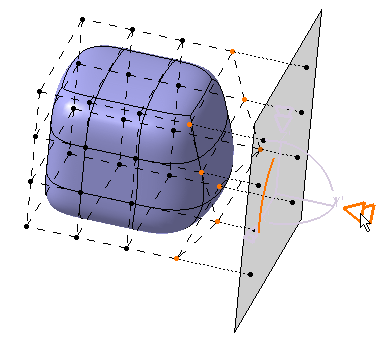
The manipulator arrows are displayed on each axis.
The manipulator is active when you are in the picking zone. You can click
anywhere in the picking zone to perform a modification.
As you are in the active manipulator zone,
the projection plane
is viewed. This plane size is defined to include all the projected
points. The interactive arrows direction
indicates the
direction of projection and
is normal to the plane.
Click the interactive arrow depending on the direction where you want
to align the vertex.
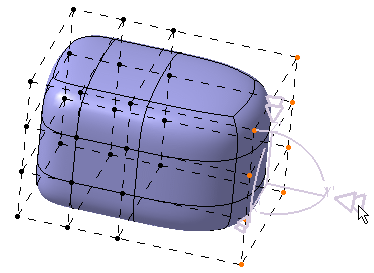
The selected
elements are projected onto the plane of the compass:
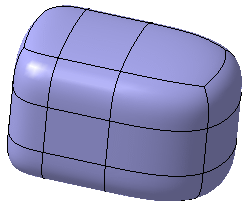

Align Vertices on an Axis
You can project
vertices onto the axis of the compass.
Click Modification
 . .
Select the surface.
Click Alignment
 . .
The Tools Palette is modified and new icons appear.Click Compass Definition
 to define the compass position and click the icon again when done.
to define the compass position and click the icon again when done. Click On Axis
 . .
Note: When this option is activated the following options are
available for surface selection:
Edge Selection,
Vertex Selection, All Elements
Selection.
Select the elements to be projected.
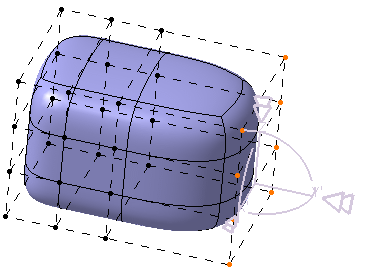
Manipulator arrows are displayed on each axis. The manipulator is active when you are in the picking zone. You can click
anywhere in the picking zone to perform a modification.
As you are in the
picking area of the manipulator, the projection axis is viewed. This axis
size is defined to include all the projected points. The interactive
arrows direction indicates the direction of projection and is normal to
the plane.
Click the manipulator arrow depending on the
direction where you want to align the vertex.

The selected elements are projected onto the normal line
of the compass:
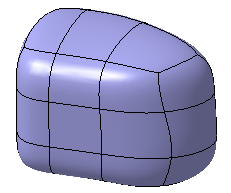

Align Vertices on a Support Element
You can project
vertices orthogonally or along a defined direction onto
a support element.
Click Modification
 . . Select the surface. Click Alignment
 . .
The Tools Palette is modified and new icons appear.Click Compass Definition
 to define the compass position and click the icon again when done.
to define the compass position and click the icon again when done. Click On Body
 . . When this option is activated the following options are
available for surface selection:
All Type Selection, Face Selection, Edge Selection,
Vertex Selection and All Elements
Selection. Select the elements to be projected. Select the support element. The manipulator is displayed with a sphere in its middle.
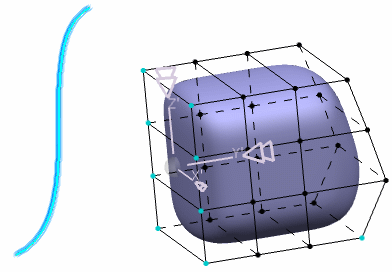
Move the mouse over: - the center of the manipulator to display arrows on each axis. Click
anywhere in the picking zone to perform an orthogonal projection.
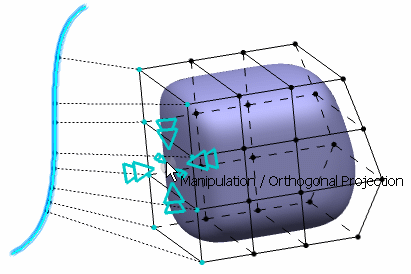
Projection traces are previewed.
- the interactive arrow corresponding to the
direction where you want to align the vertices to perform a projection along a direction.
As you can see below, it is not mandatory that the target be in the same plane as the vertices to project.
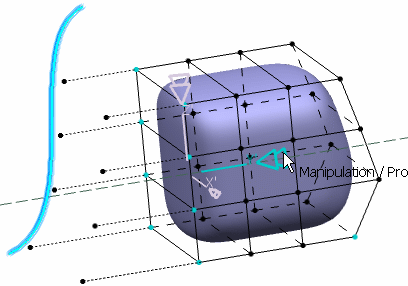
The direction of the interactive arrows indicates the direction of
projection. Projection traces are previewed. The distance between the projection traces and the projection support is computed. Note:
You can click on an arrow and move the mouse towards the geometry to perform an exact aligment:
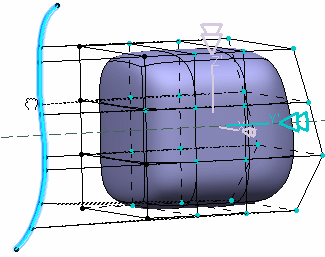
The selected elements are projected onto the support element, as shown below: Orthogonal projection

Projection along a direction

|

![]()












